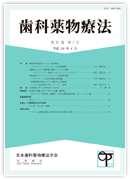
- Issue 1 Pages 1-
- |<
- <
- 1
- >
- >|
-
[in Japanese]2025Volume 44Issue 1 Article ID: 25.03
Published: 2025
Released on J-STAGE: April 19, 2025
JOURNAL RESTRICTED ACCESSDownload PDF (990K)
-
AKIRA YAMAGUCHI, TOSHIHIKO TAKENO2025Volume 44Issue 1 Pages 1-10
Published: 2025
Released on J-STAGE: April 19, 2025
JOURNAL RESTRICTED ACCESSIn clinical dentistry, it is not uncommon to encounter situations involving bleeding, such as traumatic injuries and intraoperative procedures, where hemostasis is difficult to achieve. In addition, patients with various hematologic diseases and those undergoing antithrombotic therapy must be well understood and prepared for replacement therapy and local hemostasis before surgery.
The body's hemostatic mechanism functions to maintain a balance between thrombogenic action, which seals the injured area with a hemostatic thrombus, and antithrombotic action, which prevents unnecessary thrombus formation. Bleeding tendency is also observed in the presence of local inflammation in addition to various hematologic and systemic diseases. On the other hand, if antithrombotic drugs are administered for thrombophilia, hemostasis may be difficult to achieve during tooth extraction or surgery.
If thrombocytopenia or coagulation factor deficiency is present, systemic replacement therapy is performed, but the basic principle of hemostasis is localized hemostasis. In dentistry, the basic approach is compression hemostasis, and if hemostasis is difficult, local hemostatic agents or a hemostatic splint may be used. Guidelines for tooth extractions in antithrombotic therapy patients recommend that, in principle, teeth should be extracted without drug withdrawal, increasing the importance of local hemostasis.
In this context, future development of simple screening tests that reflect each stage of the hemostatic mechanism and local hemostatic agents suited to the situation is expected.
View full abstractDownload PDF (3281K)
-
HIROSHI IWABUCHI, YUTAKA WATANABE, SHUJI TOYA, YUYA NAKATANI, TAKAFUMI ...2025Volume 44Issue 1 Pages 11-16
Published: 2025
Released on J-STAGE: April 19, 2025
Advance online publication: March 12, 2025JOURNAL RESTRICTED ACCESSThe relationship between the oral mucosal wetness level and saliva production was examined using MucuseTM, an oral moisture-checking device of Murata Manufacturing Co., Ltd. The 117 subjects were patients with untreated xerostomia who visited participating centers regularly. Saliva production was analyzed using weight of saliva in a gum test, gum test weight values. The median (minimum-maximum) saliva weight was 6.0 (0-21.1) g and the median oral mucosal wetness level was 30.9 (6.7-36.0). The correlation coefficient of oral mucosal wetness levels with gum test weight values was 0.202 (p=0.029). Using a standard gum test weight value of 10 g for xerostomia, the median oral mucosal wetness level was significantly lower in 92 subjects with a value lower than the standard compared to that in 25 subjects with higher values (30.8 (6.7-34.1) vs. 31.3 (28.1-36.0), p=0.017). Receiver operator characteristics (ROC) analysis gave AUC=0.654 (p=0.017) at a cutoff value of 30.9, and oral mucosal wetness levels of 30.3 and 32.2 when sensitivity and specificity were ≥80%, respectively. The cutoff value for xerostomia was 30.3 and that for healthy persons was 32.2, suggesting a boundary zone from 30.4-32.1.
View full abstractDownload PDF (1579K) -
MITSURU TAKATA, KAZUMITSU AOKI, TETSUSHI OKUMURA, YASUNOBU BUSUJIMA2025Volume 44Issue 1 Pages 17-23
Published: 2025
Released on J-STAGE: April 19, 2025
Advance online publication: April 04, 2025JOURNAL RESTRICTED ACCESSWe conducted a clinical study on patients with post-tooth extraction bleeding who required treatment. A retrospective investigation was performed using the medical records of 71 patients to examine the use of antithrombotic drugs, the presence of underlying conditions necessitating antithrombotic therapy, bleeding sites, hemostatic methods, and the relationship between bleeding and antithrombotic therapy.
The bleeding sites were classified into four areas for both the upper and lower jaws:anterior teeth, premolars, molars, and wisdom teeth. The causes of post-extraction bleeding and the role of antithrombotic therapy were also evaluated for patients treated with surgical splints and patients treated with tamponade. Hemostatic methods were categorized into three grades:Grade 1, where gauze pressure alone was sufficient; Grade 2, where surgical treatment such as suturing was required; and Grade 3, where systemic hemostatic treatment such as intravenous therapy was necessary in addition to surgical treatment.
Of the 71 cases, seven patients were treated with Grade 1 methods and 64 with Grade 2 methods. Across the 87 sites where hemostasis was performed, seven were Grade 1, 80 were Grade 2, and none were Grade 3. Among the Grade 2 cases, seven patients (12 sites) were managed with sutures alone, 43 patients (51 sites) were treated with a combination of sutures and local hemostatic agents, six patients (seven sites) required a surgical splint, and eight patients (10 sites) were managed with tamponade.
This study demonstrates that although post-extraction bleeding is primarily caused by local factors, patients receiving anticoagulants as part of antithrombotic therapy—especially those using warfarin—require additional caution. For these patients, surgical splints and tamponade should be employed from the outset, and postoperative medication adherence should be emphasized.
View full abstractDownload PDF (1765K)
-
2025Volume 44Issue 1 Pages 25-27
Published: 2025
Released on J-STAGE: April 19, 2025
JOURNAL RESTRICTED ACCESSDownload PDF (1977K)
-
[in Japanese]2025Volume 44Issue 1 Pages 29-30
Published: 2025
Released on J-STAGE: April 19, 2025
JOURNAL RESTRICTED ACCESSDownload PDF (1143K)
- |<
- <
- 1
- >
- >|